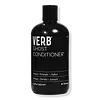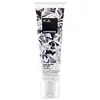What's inside
What's inside
 Key Ingredients
Key Ingredients

No key ingredients
 Benefits
Benefits

 Concerns
Concerns

 Ingredients Side-by-side
Ingredients Side-by-side

Water
Skin ConditioningCetearyl Alcohol
EmollientBehentrimonium Methosulfate
Cetyl Alcohol
EmollientPanthenol
Skin ConditioningHydrolyzed Soy Protein
HumectantHydrolyzed Rice Protein
Skin ConditioningSaccharum Officinarum Extract
MoisturisingAloe Barbadensis Leaf Juice
Skin ConditioningHydrolyzed Vegetable Protein Pg-Propyl Silanetriol
Skin ConditioningCitrus Aurantium Dulcis Fruit Extract
MaskingCitrus Limon Fruit Extract
MaskingPyrus Malus Fruit Extract
Skin ConditioningSimmondsia Chinensis Seed Oil
EmollientMoringa Oleifera Seed Oil
EmollientTheobroma Cacao Seed Butter
EmollientHydrolyzed Quinoa
Skin ConditioningCamellia Sinensis Leaf Extract
AntimicrobialHelianthus Annuus Seed Extract
Skin ConditioningEthylhexylglycerin
Skin ConditioningTocopherol
AntioxidantStearamidopropyl Dimethylamine
EmulsifyingCetrimonium Chloride
AntimicrobialBehentrimonium Chloride
PreservativePolysorbate 60
EmulsifyingParfum
MaskingCitric Acid
BufferingIsopropyl Alcohol
SolventMagnesium Nitrate
Hydrogenated Castor Oil/Sebacic Acid Copolymer
EmollientTetrasodium EDTA
Sodium Hydroxide
BufferingMagnesium Chloride
Benzyl Alcohol
PerfumingMethylchloroisothiazolinone
PreservativePhenoxyethanol
PreservativeMethylisothiazolinone
PreservativeSodium Benzoate
MaskingPotassium Sorbate
PreservativeDisodium EDTA
Butylphenyl Methylpropional
PerfumingLimonene
PerfumingWater, Cetearyl Alcohol, Behentrimonium Methosulfate, Cetyl Alcohol, Panthenol, Hydrolyzed Soy Protein, Hydrolyzed Rice Protein, Saccharum Officinarum Extract, Aloe Barbadensis Leaf Juice, Hydrolyzed Vegetable Protein Pg-Propyl Silanetriol, Citrus Aurantium Dulcis Fruit Extract, Citrus Limon Fruit Extract, Pyrus Malus Fruit Extract, Simmondsia Chinensis Seed Oil, Moringa Oleifera Seed Oil, Theobroma Cacao Seed Butter, Hydrolyzed Quinoa, Camellia Sinensis Leaf Extract, Helianthus Annuus Seed Extract, Ethylhexylglycerin, Tocopherol, Stearamidopropyl Dimethylamine, Cetrimonium Chloride, Behentrimonium Chloride, Polysorbate 60, Parfum, Citric Acid, Isopropyl Alcohol, Magnesium Nitrate, Hydrogenated Castor Oil/Sebacic Acid Copolymer, Tetrasodium EDTA, Sodium Hydroxide, Magnesium Chloride, Benzyl Alcohol, Methylchloroisothiazolinone, Phenoxyethanol, Methylisothiazolinone, Sodium Benzoate, Potassium Sorbate, Disodium EDTA, Butylphenyl Methylpropional, Limonene
Water
Skin ConditioningDimethicone
EmollientSorbitol
HumectantPropylene Glycol
HumectantBehenyl Alcohol
EmollientStearyl Alcohol
EmollientBehentrimonium Chloride
PreservativeCetyl Alcohol
EmollientHelianthus Annuus Seed Oil
EmollientAloe Barbadensis Leaf Juice
Skin ConditioningAlgae Extract
EmollientPhyllanthus Emblica Fruit Extract
HumectantMacrocystis Pyrifera Extract
Skin ConditioningGlyceryl Oleate
EmollientSteartrimonium Chloride
PreservativePEG-40 Hydrogenated Castor Oil
EmulsifyingPEG-4 Laurate
EmulsifyingPEG-6 Methyl Ether Dimethicone
EmulsifyingPEG-90m
Emulsion StabilisingPPG-26-Buteth-26
Skin ConditioningEthylhexyl Methoxycinnamate
UV AbsorberButyl Methoxydibenzoylmethane
UV AbsorberEthylhexyl Salicylate
UV AbsorberDisodium EDTA
Glycerin
HumectantAminopropyl Dimethicone
Silicone Quaternium-16
Skin ConditioningUndeceth-11
EmollientUndeceth-5
EmulsifyingButyloctanol
HumectantSodium Citrate
BufferingIsopropyl Alcohol
SolventSodium Hydroxide
BufferingCitric Acid
BufferingIodopropynyl Butylcarbamate
PreservativePhenoxyethanol
PreservativeParfum
MaskingBenzyl Salicylate
PerfumingCoumarin
PerfumingGeraniol
PerfumingLimonene
PerfumingLinalool
PerfumingWater, Dimethicone, Sorbitol, Propylene Glycol, Behenyl Alcohol, Stearyl Alcohol, Behentrimonium Chloride, Cetyl Alcohol, Helianthus Annuus Seed Oil, Aloe Barbadensis Leaf Juice, Algae Extract, Phyllanthus Emblica Fruit Extract, Macrocystis Pyrifera Extract, Glyceryl Oleate, Steartrimonium Chloride, PEG-40 Hydrogenated Castor Oil, PEG-4 Laurate, PEG-6 Methyl Ether Dimethicone, PEG-90m, PPG-26-Buteth-26, Ethylhexyl Methoxycinnamate, Butyl Methoxydibenzoylmethane, Ethylhexyl Salicylate, Disodium EDTA, Glycerin, Aminopropyl Dimethicone, Silicone Quaternium-16, Undeceth-11, Undeceth-5, Butyloctanol, Sodium Citrate, Isopropyl Alcohol, Sodium Hydroxide, Citric Acid, Iodopropynyl Butylcarbamate, Phenoxyethanol, Parfum, Benzyl Salicylate, Coumarin, Geraniol, Limonene, Linalool
 Reviews
Reviews

Ingredients Explained
These ingredients are found in both products.
Ingredients higher up in an ingredient list are typically present in a larger amount.
Aloe Barbadensis Leaf Juice comes from leaves of the aloe plant. Aloe Barbadensis Leaf Juice is best known for helping to soothe sunburns. It is also anti-inflammatory, moisturizing, antiseptic, and can help heal wounds.
Aloe is packed with good stuff including Vitamins A, C, and E. These vitamins are antioxidants, which help fight free-radicals and the damage they may cause. Free-radicals are molecules that may damage your skin cells, such as pollution.
Aloe Barbadensis Leaf Juice also contains sugars. These sugars come in the form of monosaccharides and polysaccharides, folic acid, and choline. These sugars are able to help bind moisture to skin.
It also contains minerals such as calcium, 12 anthraquinones, fatty acids, amino acids, and Vitamin B12.
Learn more about Aloe Barbadensis Leaf JuiceThis ingredient is a preservative and often used for it's anti-static properties. You'll most likely see this ingredient in hair conditioners.
It does not cause irritation or sensitization in leave-on products at 1-5%.
Cetyl Alcohol is a fatty alcohol. Fatty Alcohols are most often used as an emollient or to thicken a product.
Its main roles are:
Though it has "alcohol" in the name, it is not related to denatured alcohol or ethyl alcohol.
The FDA allows products labeled "alcohol-free" to have fatty alcohols.
Learn more about Cetyl AlcoholCitric Acid is an alpha hydroxy acid (AHA) naturally found in citrus fruits like oranges, lemons, and limes.
Like other AHAs, citric acid can exfoliate skin by breaking down the bonds that hold dead skin cells together. This helps reveal smoother and brighter skin underneath.
However, this exfoliating effect only happens at high concentrations (20%) which can be hard to find in cosmetic products.
Due to this, citric acid is usually included in small amounts as a pH adjuster. This helps keep products slightly more acidic and compatible with skin's natural pH.
In skincare formulas, citric acid can:
While it can provide some skin benefits, research shows lactic acid and glycolic acid are generally more effective and less irritating exfoliants.
Most citric acid used in skincare today is made by fermenting sugars (usually from molasses). This synthetic version is identical to the natural citrus form but easier to stabilize and use in formulations.
Read more about some other popular AHA's here:
Learn more about Citric AcidDisodium EDTA plays a role in making products more stable by aiding other preservatives.
It is a chelating agent, meaning it neutralizes metal ions that may be found in a product.
Disodium EDTA is a salt of edetic acid and is found to be safe in cosmetic ingredients.
Learn more about Disodium EDTAIsopropyl Alcohol is more commonly known as rubbing alcohol. It is most commonly used as a solvent, meaning it helps other ingredients dissolve.
This ingredient is an astringent alcohol. Astringent alcohols may also irritate skin as they high amounts may strip away your skin's natural oils.
Other types of astringent alcohols include:
According to the National Rosacea Society based in the US, you should be mindful of products with these alcohols in the top half of ingredients.
Any type of sanitizing product will have high amounts of alcohol to help kill bacteria and viruses.
Learn more about Isopropyl AlcoholLimonene is a fragrance that adds scent and taste to a formulation.
It's found in the peel oil of citrus fruits and other plants such as lavender and eucalyptus. The scent of limonene is generally described as "sweet citrus".
Limonene acts as an antioxidant, meaning it helps neutralize free radicals.
When exposed to air, oxidized limonene may sensitize the skin. Because of this, limonene is often avoided by people with sensitive skin.
The term 'fragrance' is not regulated in many countries. In many cases, it is up to the brand to define this term. For instance, many brands choose to label themselves as "fragrance-free" because they are not using synthetic fragrances. However, their products may still contain ingredients such as essential oils that are considered a fragrance.
Learn more about LimoneneParfum is a catch-all term for an ingredient or more that is used to give a scent to products.
Also called "fragrance", this ingredient can be a blend of hundreds of chemicals or plant oils. This means every product with "fragrance" or "parfum" in the ingredients list is a different mixture.
For instance, Habanolide is a proprietary trade name for a specific aroma chemical. When used as a fragrance ingredient in cosmetics, most aroma chemicals fall under the broad labeling category of “FRAGRANCE” or “PARFUM” according to EU and US regulations.
The term 'parfum' or 'fragrance' is not regulated in many countries. In many cases, it is up to the brand to define this term.
For instance, many brands choose to label themselves as "fragrance-free" because they are not using synthetic fragrances. However, their products may still contain ingredients such as essential oils that are considered a fragrance by INCI standards.
One example is Calendula flower extract. Calendula is an essential oil that still imparts a scent or 'fragrance'.
Depending on the blend, the ingredients in the mixture can cause allergies and sensitivities on the skin. Some ingredients that are known EU allergens include linalool and citronellol.
Parfum can also be used to mask or cover an unpleasant scent.
The bottom line is: not all fragrances/parfum/ingredients are created equally. If you are worried about fragrances, we recommend taking a closer look at an ingredient. And of course, we always recommend speaking with a professional.
Learn more about ParfumPhenoxyethanol is a preservative that has germicide, antimicrobial, and aromatic properties. Studies show that phenoxyethanol can prevent microbial growth. By itself, it has a scent that is similar to that of a rose.
It's often used in formulations along with Caprylyl Glycol to preserve the shelf life of products.
Sodium Hydroxide is also known as lye or caustic soda. It is used to adjust the pH of products; many ingredients require a specific pH to be effective.
In small amounts, sodium hydroxide is considered safe to use. However, large amounts may cause chemical burns due to its high alkaline.
Your skin has a natural pH and acid mantle. This acid mantle helps prevent harmful bacteria from breaking through. The acid mantle also helps keep your skin hydrated.
"Alkaline" refers to a high pH level. A low pH level would be considered acidic.
Learn more about Sodium HydroxideWater. It's the most common cosmetic ingredient of all. You'll usually see it at the top of ingredient lists, meaning that it makes up the largest part of the product.
So why is it so popular? Water most often acts as a solvent - this means that it helps dissolve other ingredients into the formulation.
You'll also recognize water as that liquid we all need to stay alive. If you see this, drink a glass of water. Stay hydrated!
Learn more about Water